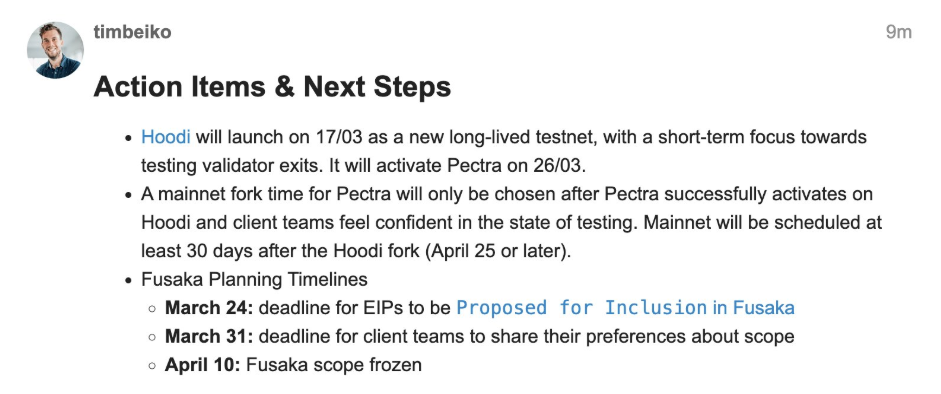Ethereum will launch the Hoodi testnet on March 17, addressing Pectra testing issues encountered on the Holesky and Sepolia testnets.
This move comes as developers work to troubleshoot bugs that could potentially delay the Sepolia fork.
Ethereum Unveils Hoodi Testnet for Pectra Testing
The Ethereum network has been working on the Pectra upgrade to introduce key Ethereum Improvement Proposals (EIPs). These proposals will enhance staking mechanisms and improve the wallet user experience.
However, Ethereum conducts tests in the run-up to its various EIPs. These probes ensure seamless upgrades and mainnet launches, citing methodical testing strategies.
The Sepolia testnet upgraded to Pectra just a week ago, marking a significant milestone in the development process. Additionally, Ethereum launched the Mekong testnet in early November to preview Pectra fork updates. This allowed developers to evaluate its features ahead of broader implementation.
However, in a February 25 post, Christine Kim, a researcher at Galaxy, highlighted the challenges faced in the testing phase of Ethereum’s Pectra Upgrade.
“Pectra is live on Holesky…Seeing a slight uptick in missed blocks but the network participation rate looks strong…some client teams are reporting issues with invalid blocks in the Eth R&D discord… lots more missed blocks and the network isn’t finalizing…Devs are troubleshooting what the issues are. Depending on the scale of the bugs, devs could delay the Sepolia fork… network is still not finalizing, the participation rate has dropped to ~50%,” Kim explained.
To establish whether these creases have been ironed out, Ethereum will launch the Hoodi testnet on Monday, March 17. If testing on Hoodi proves successful, the Pectra upgrade could go live on Ethereum’s mainnet by late April. However, according to Tim Beiko, a key Ethereum developer, delays extending into May remain possible.
“A new testnet, Hoodi, is going live Monday to wrap up Pectra testing. If you need to test validator exits, be on the lookout for it! Everything else can be tested on Sepolia & Holesky. Pectra will be scheduled 30+ days after Hoodi forks successfully, pending infra and client testing. Fusaka planning will run in parallel, with a deadline of March 24 to propose EIPs, and a tentative date of April 10 for a scope freeze,” Beiko articulated.

This means that the Ethereum Pectra Upgrade is contingent on successful testing on Hoodi after previous testnets. With the Hoodi testnet slated for March 17 and Pectra Upgrade at least 30 days thereafter, the update could go live as soon as April 17 or later. Some users expressed dissatisfaction with this delay.
“Pectra delayed by a month. Core devs really can’t ship anything in time,” one user remarked.
Nevertheless, others seemed unsurprised by the timeline, an understanding that likely appreciates the rigorousness of delivering seamless mainnet launches. The launch of the Hoodi testnet next week represents a crucial step in ensuring the stability and effectiveness of the Pectra upgrade.
With developer scrutiny intensifying and planned improvements in staking and user experience, Ethereum’s roadmap focuses on long-term scalability and security enhancements for its network.
“I’m stoked this could make ETH even sharper and more efficient,” a user on X remarked.
Fusaka, the next major upgrade, will follow in 2026. While details remain scarce, Fusaka promises to refine Ethereum’s scalability and efficiency further. This will advance the network’s evolution toward greater usability and adoption.
The post Hoodi Testnet to Test Ethereum’s Pectra Upgrade Before Mainnet Launch appeared first on BeInCrypto.




